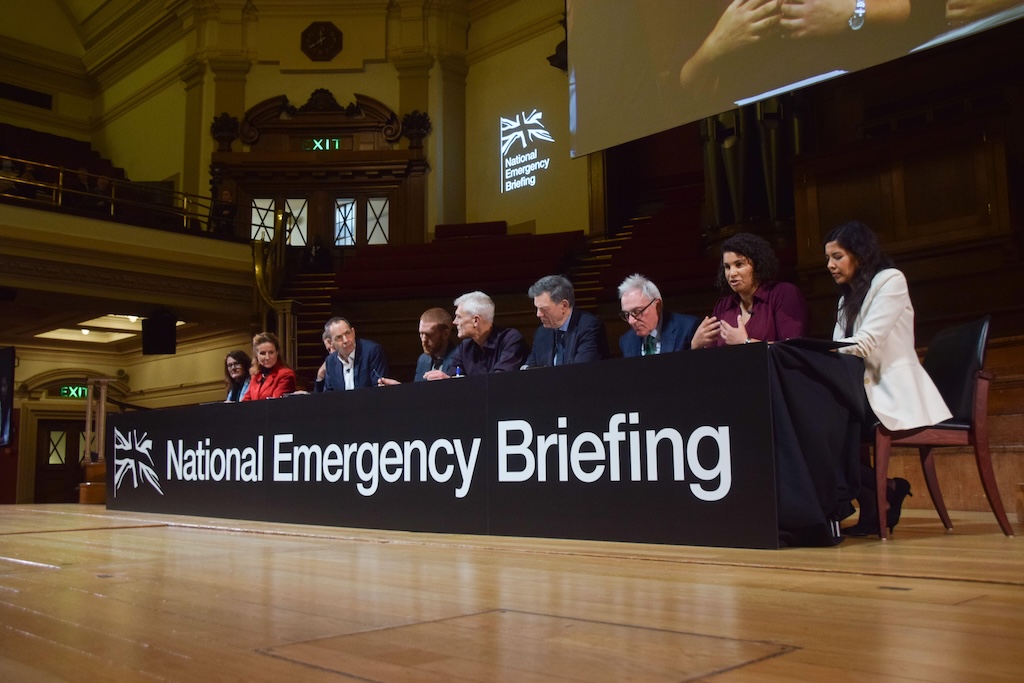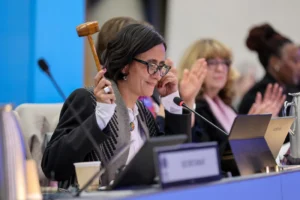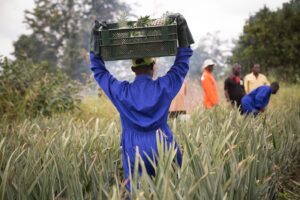The Trump administration in the US has imposed tariffs on all imports from China, Mexico and Canada, as well as on steel, aluminium and cars from around the world.
In response, the US has been hit with retaliatory tariffs from major trading partners, including the EU.
US president Donald Trump has said he intends to launch a further round of reciprocal tariffs on 2 April, targeting a broader range of countries.
This escalating “trade war” is expected to slow global growth and has also triggered warnings of a US recession.
Global energy flows and efforts to tackle climate change are already being affected by the escalating trade tensions.
The tariffs are expected to disrupt the global trade in clean technologies, from electric cars to the materials used to build wind turbines.
At the same time, as high-emitting industries face higher costs, some commentators have suggested that tariffs could hamper US plans for fossil-fuel expansion.
And as clean technology becomes more expensive to manufacture in the US, other nations – particularly China – are likely to step up to fill in any gaps.
Carbon Brief has asked a range of researchers and policy experts what they think Trump’s tariffs could mean for global climate action and energy supplies.
These are their responses, first as sample quotes, then, below, in full:
- Dr Kyle Chan: “With US automakers struggling to compete, Chinese electric vehicle companies will likely gain a stronger position.”
- Elisabetta Cornago: “China may redirect its exports towards the relatively open EU market, challenging homegrown clean-tech industries at a time when the EU is trying to support and revitalise them.”
- Dr Bentley Allan and Dr Tim Sahay: “G7 and G20 countries are strengthening their domestic economies with deficit financing and directed investments into strategic sectors, such as green and digital sectors”
- Alex Muresianu: “A less productive US economy, which must pay higher prices for key inputs, is one that can spare fewer resources to address climate change.”
- Antoine Vagneur-Jones: “The administration’s fondness for data centres requires significant grid investment and yet the US relies on its neighbours for its supply of large power transformers.”
- Jimena Blanco: “The US is mainly or wholly import-reliant for around four-fifths of its identified 50 critical minerals, including from its partners Canada and Mexico.”
- Dr Simi Thambi: “An increase in trade protectionism is not good for climate action.”
- Robert Rozansky: “One upside to Trump’s trade war is that it might stymie his efforts to push US liquified natural gas (LNG) expansion into overdrive.”
- Chris Severson-Baker: “The Canadian oil and gas lobby…has been using this moment to make the case for more oil and gas production and infrastructure.”
- Anne-Sophie Corbeau: “Trump’s tariffs have already had an impact on LNG trade…China has not imported a single US LNG cargo since 6 February.”
- Avantika Goswami: “Tariffs – if imposed widely – may hurt the exports of countries like India, which nurture aspirations to mimic China’s role as an exporter of green goods.”
- Tu Le: “If manufacturers have to move multiple factories, that changes, reduces or eliminates what would have likely been more investment in research and development for clean energy vehicles.”
- Ellie Belton: “A more unpredictable US could create opportunities for the UK and EU to attract low-carbon investment and gain a competitive edge in the energy transition.”
- Eileen Torres Morales: “The effects of Trump’s tariffs on the global transition to green iron and steelmaking are still uncertain.”
- Dr Aurélien Saussay: “When faced with increased economic pressures from tariffs, countries could be more tempted to relax environmental standards to maintain competitiveness.”
Dr Kyle Chan
Postdoctoral researcher and author of High Capacity
Trump’s tariffs will likely have wide-ranging effects on China’s clean-tech industry and global climate progress. Higher tariffs on China will directly impact US imports of Chinese clean tech goods, such as lithium batteries, which reached $1.9bn in December 2024.
Chinese solar manufacturing firms will also be hit indirectly through tariffs on production sites in south-east Asia, which collectively supplies 80% of US solar imports. Meanwhile, China’s retaliation could disrupt US access to critical minerals for its own clean-tech industry. This includes graphite for battery anodes and rare earth metals for wind turbines.
The impact on China’s electric vehicle industry in particular will be consequential, albeit less direct. Chinese electric vehicle imports to the US, which were already minimal, will not be significantly affected by Trump’s new tariffs.
However, the broader disruption to automotive supply chains across Mexico and Canada – along with rising steel and aluminium costs – will weaken the ability of US automakers to transition to electric vehicles. This will benefit Chinese electric vehicle makers, which continue to innovate and drive down costs.
With US automakers struggling to compete, Chinese electric vehicle companies will likely gain a stronger position, not just in China’s domestic market, but globally as well.
 Elisabetta Cornago
Elisabetta Cornago
Senior research fellow, EU energy and climate policy
Centre for European Reform
The Trump administration is walking back on US climate commitments, both domestically by threatening to cut back Inflation Reduction Act (IRA) support for clean-tech industries and internationally, [by] withdrawing from the Paris Agreement. US tariffs can also affect climate action and the energy transition globally, hitting global value chains for clean technologies.
The Trump administration has levied tariffs on primary materials, such as steel and aluminium, on the EU as well as on China. This will increase manufacturing costs for US-based producers of goods that rely on imports of those materials, such as wind turbines and electric vehicles.
But, at the same time, because of interconnections in global value chains, the EU will also be impacted by US tariffs that are currently limited to China.
Tariffs on Chinese exports of solar panels, electric vehicles and batteries to the US, for example, will reinforce China’s overcapacity in manufacturing in all these sectors, relative to weak Chinese demand. As a consequence, China may redirect its exports towards the relatively open EU market, challenging homegrown clean tech industries at a time when the EU is trying to support and revitalise them.
Trump’s self-harming retreat on climate and tariffs has caused uncertainty for clean energy, industry and trade. There is a macroeconomic slowdown that could negatively impact the rising green investments of the last decade.
However, countries are strategic actors, not just passive victims of US trade policy. We are observing G7 and G20 countries take anticipatory steps.
First, they are strengthening their domestic economies with deficit financing and directed investments into strategic sectors, such as green and digital sectors. A few examples:
- The monumental shift in German fiscal policy will now enable investments in climate.
- The overhaul of EU’s fiscal rules and greater funding of the EU’s industrial deal with over €100bn to support clean manufacturing.
- Brazilian president Luiz Inácio Lula da Silva has unfurled Nova Industria Brasil to build green industrialisation.
- Mexican president Claudia Sheinbaum has announced and funded Plan Mexico for strategic investments.
Many nations are also diversifying their markets and multilateralist diplomacy. Targets of Trump tariff threats are involved in a flurry of trade and investment deals:
- Within Asia, there are negotiations to green the world’s largest trade bloc – the Regional Comprehensive Economic Partnership.
- Trade deals between Mexico-EU, EU-Brazil and Canada-EU are being revamped to allow more green trade.
- Countries such as Brazil and South Africa are leading diplomatic efforts through their presidencies of BRICS and G20 this year to articulate new trading and financial architecture that gives them the policy space to pursue green structural transformation to meet domestic and global climate goals.
 Alex Muresianu
Alex Muresianu
Senior policy analyst
Tax Foundation
At the most basic level, gains from trade are valuable. Historically, trade barriers have slowed the spread and adoption of new technology. The fight against climate change is just one example of the many economic challenges these tariffs will make more difficult.
Tariffs on important inputs make building more expensive and distort the US economy toward less productive activity. A less productive US economy, which must pay higher prices for key inputs, is one that can spare fewer resources to address climate change.
Advocates of Trump’s approach to trade often invoke competition with China as a justification. However, most of Trump’s tariffs are targeted at allied or friendly nations, such as Canada, Mexico and members of the EU. US policymakers are worried about losing an innovation race with China in areas like electric vehicles or other green technologies, but putting up barriers to other markets will make us less – not more – competitive in the long term.
 Antoine Vagneur-Jones
Antoine Vagneur-Jones
Head of trade and supply chains
BloombergNEF
The tariffs jar with priorities that are – at least rhetorically – at the heart of the Trump presidency.
The administration’s fondness for data centres requires significant grid investment and yet the US relies on its neighbours for its supply of large power transformers. Expanding manufacturing is another apparent priority, but increasing the cost of inputs will crimp domestic industry.
And by hurting cross-border value chains and taxing imported crude, the tariffs could conceivably disadvantage traditional internal combustion engine vehicles more than their electrified equivalents.
 Jimena Blanco
Jimena Blanco
Chief analyst
Verisk Maplecroft
Against a background of tariffs and disrupted trading relationships, we are seeing a more protectionist stance towards critical minerals emerging, further complicating clean-tech supply chains.
Our research shows resource nationalism is accelerating. Among the emerging markets, 17 major critical mineral producers have seen a significant increase in risk in the past five years, including Chile and Peru – both key sources of lithium and copper.
Exact details of the new US tariff regime won’t be known until 2 April, but it is likely that the next batch of tariffs will be levied most heavily on countries with the largest trade imbalances. These countries represent the majority of Washington’s key global trade partners, meaning disruptions to supply chains – including in minerals essential for the energy transition – are increasingly likely.
The US is mainly or wholly import-reliant for around four-fifths of its identified 50 critical minerals, including from its US-Mexico-Canada Agreement (USMCA) partners Canada and Mexico. If Canada, for example, responds to the imposition of tariffs by the US with new export taxes, bans or restrictions on mineral exports, increasing costs or supply shortages are a prospect that US businesses will have to adapt to.
There is potential for US tariffs to slow the rollout of green policies if nations view renewables mandates or more stringent carbon regulation as adding additional burdens to their economy at a time of increasing trade friction. However, this could be counterbalanced somewhat by investments in low-carbon solutions such as carbon capture, utilisation and storage (CCUS) or hydrogen.
 Dr Simi Thambi
Dr Simi Thambi
Climate economist
FAIRR
An increase in trade protectionism is not good for climate action. Climate scientists have conceptualised this as a scenario of rising retaliatory tariffs – Shared Socioeconomic Pathway 3 (SSP3) – where challenges to mitigation and adaptation are high, making it unlikely for the world to limit temperature rise to 1.5C by the end of the century. This scenario could lead to up to four times more emissions than a sustainability-focused pathway with low challenges to mitigation and adaptation.
Mitigation is very challenging in this scenario because reducing emissions is more expensive, as investments needed to scale clean technologies are not prioritised. As a result, these technologies fail to penetrate well into the markets that need them most cost-effectively. For example, according to the International Energy Agency’s (IEA) 2024 electric vehicle outlook, electric vehicle sales in emerging markets remain very low. Lowering global emissions without greening the transport sector in developing economies would be highly challenging.
Adaptation also faces considerable challenges in SSP3, because one can expect deforestation and cropland expansion to rise in this scenario, as countries focus on their national ambitions. Extensive deforestation would reduce ecosystems and biodiversity, reducing their adaptive capacity.
 Robert Rozansky
Robert Rozansky
Global LNG analyst and project manager, Europe gas tracker
Global Energy Monitor
The Trump administration has gone all in on promoting US LNG under its “America first”, “energy dominance” agenda. As it seeks to boost new LNG production projects that are still on the drawing board, such as the Alaska LNG project touted in the State of the Union address, the US could further exacerbate a global overbuild of LNG infrastructure that threatens international climate targets. At the same time, the Trump administration’s trade war may make these same proposed LNG projects more difficult to build and finance.
Tariffs will raise the cost of raw materials, such as steel, the “backbone of LNG facilities”. If tariffs lead to economy-wide inflation, labour could become more expensive, too. The LNG industry is no stranger to the toll of inflation. For example, the cost of the under-construction Golden Pass LNG Terminal rose by $2bn after its main contractor declared bankruptcy in May citing pandemic-related cost inflation and delays.
If it becomes more expensive to build LNG export terminals in the US, financiers committed to projects under construction may struggle to recover their investments and those evaluating proposed facilities may be hesitant to invest.
The longer proposed projects sit without financial backers, the less likely it is they will get off the ground at all. New US LNG terminals are already set to face steep competition from an incoming wave of export projects abroad and increasingly cheap renewable power, as an alternative to gas.
Given that LNG may be roughly as bad for the climate as coal, if not worse, one upside to Trump’s trade war is that it might stymie his efforts to push US LNG expansion into overdrive.
 Chris Severson-Baker
Chris Severson-Baker
Executive director
Pembina Institute
In Canada, this is unfolding into a national debate about how best to strengthen our economic resilience and ensure long-term prosperity in the face of a hostile US.
There is a risk that what president Trump is doing could cause knee-jerk reactions here in Canada. The Canadian oil and gas lobby, for example, has been using this moment to make the case for more oil and gas production and infrastructure, to get more of its products to markets outside the US.
While we agree that Canada needs to diversify its trading partners, doubling down on oil and gas exports would not provide the long-term economic resiliency and energy security our country is seeking right now. We should look instead at Europe, where governments are aggressively decarbonising their economies, not only for climate reasons. They also understand that clean energy and new technologies are associated with less price volatility and more secure supplies, as well as health and affordability benefits for citizens.
The EU’s forthcoming carbon border adjustment mechanism (CBAM) will give an advantage to low-carbon exports of steel, aluminium and cement. These are all industries that Canada is well-placed to lead on, given our abundance of emissions-free electricity to power them. However, this can only happen if we retain our nationwide industrial carbon pricing system.
That is also why the next big nation-building project we foresee in Canada is not oil and gas infrastructure, but widespread electrification, supported by a buildout and modernisation of our electricity grid. This would help Canadians become more resilient, both to the economic impacts of trade disputes and the physical and economic impacts of climate change.
 Anne-Sophie Corbeau
Anne-Sophie Corbeau
Global research scholar at the Center on Global Energy Policy
Columbia University
Trump’s tariffs have already had an impact on LNG trade. After the Trump administration imposed new tariffs on China in early February 2025, China retaliated by announcing, among other things, a 15% tariff on US LNG. China and the US are not too dependent on each other in LNG trade, with US LNG representing only 6% of China’s LNG supply in 2024. But China has not imported a single US LNG cargo since 6 February, as Chinese offtakers of US LNG are diverting their cargoes to other regions to avoid tariffs.
However, China and the US are respectively the largest LNG importer and exporter globally. Chinese buyers have contracted significant amounts of US LNG between 2021 and 2023. Should tariffs persist or even increase, US LNG will likely continue to be diverted to other countries, making the whole global LNG market less efficient. Meanwhile, Chinese buyers may become hesitant to contract more US LNG.
Another country that may be at risk if trade relations deteriorate is Mexico. Mexico’s energy system is very dependent on gas. It is also uniquely dependent on imports of US pipeline gas, which is cheaper than LNG imports. There are also a few Mexican LNG export projects at different stages of advancement that rely on US gas supplies and are therefore in competition with US-based LNG projects. Uncertainties over the bilateral relationship could become a source of risk for Mexico.
 Avantika Goswami
Avantika Goswami
Programme manager, climate change
Centre for Science and Environment
Donald Trump’s use of tariffs as an economic weapon is an attempt to regain dominance in the US’ trade relationships, for varying reasons – one being the US’ massive trade deficit.
From a climate perspective, tariffs need to be situated within a larger picture. They are likely to raise costs for general goods in the US – and green goods are not excluded from this calculus. This comes at a time when the US is lagging behind east and south-east Asia in the manufacturing of green technologies and has been slow in its domestic energy transition.
Tariffs may further raise the cost of the transition in the US. In tandem with attempts to expand oil and gas production in the domestic energy mix as Trump promises – and also any successful reindustrialisation efforts – this could see a rise in US domestic emissions. Meanwhile, fossil fuel exports will raise emissions elsewhere.
Tariffs – if imposed widely – may hurt the exports of countries like India, which nurture aspirations to mimic China’s role as an exporter of green goods. There has been an increase in the export of solar technology from India to the US, with India’s share of the country’s module imports rising from 2.5% in 2022 to 10.7% in 2024, amounting to approximately $2bn in 2023-24. For a country with aspirations in green manufacturing, tariffs on green goods could undermine this positive momentum for India.
This shift toward protectionism in the US does not necessarily spell the collapse of the global green goods market. Instead, it may serve to strengthen China’s role in the global green technology supply chain.
Lastly, the return to protectionism, particularly green protectionism, is an act of hypocrisy by nations like the US, which have spent years denouncing the same policies at the World Trade Organization when undertaken by developing countries.
 Tu Le
Tu Le
Managing director
Sino Auto Insights
It is important to take the Trump administration’s individual actions in totality, while also keeping in the back of your mind that the US is the second largest passenger vehicle market in the world. That drives the need for legacy automakers to sell into this market.
The tariffs force companies to review their long-term manufacturing strategy. If they have to move multiple factories, that changes, reduces or eliminates what would have likely been more investment in research and development for clean energy vehicles, due to their limited capital.
The Trump administration is also poised to eliminate the more stringent Environmental Protection Agency (EPA) vehicle emissions standards that would have taken effect in 2027. If successful, that would substantially reduce the urgency for global original equipment manufacturers to launch products with more efficient powertrains. And it pushes out the need for oil companies in Russia, the Middle East and the US to alter or reduce their investments in clean energy initiatives.
Legacy manufacturers play a role in this as well, since their leadership years ago seemed to be so bullish in their ability to easily move over to clean energy vehicles. Their initial sales forecasts for this timeframe were never realistic and it put a spotlight on this being a left versus right issue, when it should have been a discussion on energy independence all along.
The US and EU governments are likely to push out their net-zero targets [for vehicles]. They were arbitrary to begin with. Now, with the Trump administration in place and European automakers whining about their inability to meet the more stringent requirements, they seem more than likely to be delayed past 2035.
 Ellie Belton
Ellie Belton
Senior policy advisor – trade and climate
E3G
It is hard to imagine a scenario in which higher tariffs will benefit the global energy transition. Even if clean technologies are not directly targeted, the complex nature of international supply chains means that there will inevitably be knock-on effects, such as through increased costs for component parts like steel and aluminium.
Retaliatory tariffs against the US will also create a domino effect, distorting trade flows worldwide and altering countries’ comparative advantage in the clean economy. The biggest risk to climate action is the uncertainty this creates, which will damage investor confidence and distract governments from driving green ambition.
But a more unpredictable US could create opportunities for the UK and EU to attract low-carbon investment and gain a competitive edge in the energy transition. Continued efforts to provide public support for decarbonisation and seek mutual gains with cooperative trade partners will enable Europe to capitalise on the growing demand for renewable technologies globally.
Trade policy may have become a geopolitical game, but the urgent need to deliver a safe climate remains as critical as ever. The world is currently stuck in crisis response mode, but it is vital that we do not lose sight of the long-term direction of travel.
 Eileen Torres Morales
Eileen Torres Morales
Research associate
Stockholm Environment Institute
The effects of Trump’s tariffs on the global transition to green iron and steelmaking are still uncertain. It will take some time to see the impact, if any, such as increased steel prices in the short term, changed trade dynamics or long-term impacts on global green steel production.
The announcement of steel tariffs has forced exporting countries to rapidly reconsider how to stay competitive in the US market. The tariffs might benefit steel producers in the US, but a likely outcome is that both public and private consumers within the US will face rising steel prices regardless of whether the steel is green or not.
Trump’s administration’s interest in research and development of US-based green iron and steel production also remains unclear. It is not yet known if incentives for steel decarbonisation considered in the IRA will remain. For example, will the negotiations to advance green iron and steel production under the US Department of Energy’s industrial demonstrations programme continue or not?
Although the imposition of tariffs by the US may temporarily shift attention away from international competition and policies focused on heavy industry transition, this should not distract from progress in establishing a market for low-carbon products.
Policy instruments, such as the EU’s emissions trading system (ETS) and CBAM, should continue to be prioritised. Such tools can support the construction of a strong internal market for green steel, thus steering attention away from tariffs, back to driving innovation in low-carbon technology and emissions reductions that contribute to global climate action.
 Dr Aurélien Saussay
Dr Aurélien Saussay
Assistant professor at the Grantham Research Institute on Climate Change and the Environment
London School of Economics and Political Science
The looming threat of Trump’s tariffs is already reshaping energy policy decisions in concerning ways.
Perhaps most alarming, from a European standpoint, is European Commission president Ursula von der Leyen’s recent suggestion that Europe should increase its imports of US shale gas-derived LNG to appease the Trump administration and avoid tariffs. This move would seriously undermine the EU’s 2050 net-zero commitment.
This potential shift illustrates how trade tensions can indirectly sabotage climate progress. I’m particularly concerned by how these tariffs could undermine the viability of carbon-pricing schemes in major economies. When faced with increased economic pressures from tariffs, countries could be more tempted to relax environmental standards to maintain competitiveness.
The steel and aluminium sectors – already struggling to decarbonise – would be especially vulnerable. Many mills have begun investing in cleaner technologies, but tariffs could force them to prioritise cost-cutting over emissions reduction.
Furthermore, the uncertainty created by trade wars makes low-carbon investments riskier. Clean energy technologies, many of which are capital intensive, require stable policy environments to attract investments. The constant threat of retaliatory tariffs dampens investor confidence.
Perhaps most importantly, retaliatory tariffs on clean-energy technologies could significantly slow the global energy transition. This is particularly the case for tariffs targeting China, which is a leader in many of the key decarbonisation technologies. By increasing costs for solar panels, wind turbines and electric vehicles, these measures would hamper deployment rates precisely when acceleration is needed.
The post Experts: What do Trump’s tariffs mean for global climate action? appeared first on Carbon Brief.
Experts: What do Trump’s tariffs mean for global climate action?
Greenhouse Gases
DeBriefed 28 November 2025: COP30’s ‘frustrating’ end; Asia floods; UK ‘emergency’ climate event
Welcome to Carbon Brief’s DeBriefed.
An essential guide to the week’s key developments relating to climate change.
This week
‘Lukewarm’ end to COP30
BYE BELÉM: The COP30 climate talks in Belém ended last weekend with countries agreeing on a goal to “triple” adaptation finance by 2035 and efforts to “strengthen” climate plans, Climate Home News reported. The final deal “fell short on the global transition away from oil, gas and coal”, the outlet said, as Brazil announced that it would bring forward voluntary roadmaps to phase out fossil fuels and deforestation, before the next COP. It was a “frustrating end” for more than 80 countries who wanted a roadmap away from fossil fuels to be part of the formal COP agreement, BBC News said.
WHAT HAPPENED?: Carbon Brief published its in-depth analysis of all the key outcomes from COP30, spanning everything from negotiations on adaptation, just transition, gender and “Article 6” carbon trading through to a round-up of pledges on various issues. Another Carbon Brief article summed up outcomes around food, forests, land and nature. Also, Carbon Brief journalists discussed the COP in a webinar held earlier this week.
ART OF THE DEAL: The “compromise” COP30 deal – known as the “global mutirão” – “exposed deep rifts over how future climate action should be pursued”, Reuters noted. The “last-ditch” agreement was reached after fossil-fuel wording negotiations between the EU and Saudi Arabia, according to the Guardian. Meanwhile, Carbon Brief revealed the “informal” list of 84 countries said to have “opposed” the inclusion of a fossil-fuel roadmap in the mutirão decision, but analysis of the list exposed contradictions and likely errors.
UNITY, SCIENCE, SENSE: The final agreement received “lukewarm praise”, said the Associated Press. Palau ambassador Ilana Seid, who chaired the coalition of small-island nations, told the newswire: “Given the circumstances of geopolitics today, we’re actually quite pleased…The alternative is that we don’t get a decision and that would have been [worse].” UN climate chief Simon Stiell said that amid “denial, division and geopolitics”, countries “chose unity, science and economic common sense”, reported the Press Trust of India.
Around the world
- Floods and landslides killed more than 200 people in Thailand and Indonesia this week, reported Bloomberg. At least 90 people also died in recent floods in Vietnam, said Al Jazeera.
- New measures to cut energy bills and a “pay-per-mile” electric-vehicle levy were among the announcements in the UK’s budget, said Carbon Brief.
- The Group of 20 (G20) leaders signed off on a declaration “addressing the climate crisis” and other issues, reported Reuters, which had no input from the US who boycotted last week’s G20 summit in South Africa.
- Canadian prime minister Mark Carney signed a deal with the province of Alberta “centred on plans for a new heavy oil pipeline”, said the Guardian, adding that Canadian culture minister and former environment minister, Steven Guilbeault, resigned from cabinet over the deal.
- Greenpeace analysis, covered by Reuters, found that permits for new coal plants in China are “on track to fall to a four-year low” in 2025.
27
The number of hours that COP30 talks went over schedule before ending in Belém last Saturday, making it the 11th-longest UN climate summit on record, according to analysis by Carbon Brief.
Latest climate research
- The risk of night-time deaths during heatwaves increased “significantly” over 2005-15 in sub-Saharan Africa | Science Advances
- Almost half of climate journalists surveyed showed “moderate to severe” symptoms of anxiety | Traumatology
- Lakes experienced “more severe” heatwaves than those in the atmosphere over the past two decades | Communications Earth & Environment
(For more, see Carbon Brief’s in-depth daily summaries of the top climate news stories on Monday, Tuesday, Wednesday, Thursday and Friday.)
Captured

The key COP30 agreement – termed the “global mutirão” – contained 69 inactive verbs, which require no action from countries, compared to 32 active ones. “Recognises”, “recalls” and “acknowledges” were used far more often than more active verbs, such as “decides”, “calls” and “requests”, showed Carbon Brief analysis.
Spotlight
Nine warnings from a UK climate and nature ‘emergency’ briefing
This week, Carbon Brief’s Orla Dwyer reports from an event where experts and campaigners sounded the alarm bell on climate change and nature loss.
Naturalist and broadcaster Chris Packham urged attendees at a climate and nature “emergency briefing” in London yesterday to “listen to the science” on climate change amid a “dangerous wave of misinformation and lies”.
The “first-of-its-kind” event heard from nine experts on the links between climate change, nature loss, health, food production, economics and national security.
Event host, Prof Mike Berners-Lee from Lancaster University, called for a “World War II level of leadership” to tackle the interconnected crises.
Hundreds of people showed up, including Green Party, Labour and Liberal Democrat MPs, leader of the Greens Zack Polanski, musician Brian Eno and actress Olivia Williams.
Here is a snapshot of what the nine speakers said in their short, but stark, presentations.
Prof Kevin Anderson, professor of energy at University of Manchester
Anderson focused on the risks of a warmer world and the sliver of emissions left in the global carbon budget, noting:
“We have to eliminate fossil fuels or temperatures will just keep going up.”
He urged a “Marshall-style” plan – referencing the 1948 post-war US plan to rebuild Europe – to ramp up actions on retrofitting, public transport and electrification.
Prof Nathalie Seddon, professor of biodiversity at University of Oxford
Nature is not a “nice to have”, but rather “critical national infrastructure”, Seddon told attendees. She called for the “need to create an economy that values nature”.
Prof Paul Behrens, British Academy global professor at University of Oxford
Behrens discussed the food security risks from climate change. Impacts such as poor harvests and food price inflation are “barely acknowledge[d]” in agricultural policy, he said.
He also emphasised the “unsustainable” land use of animal agriculture, which “occupies around 85% of total agricultural land” in the UK.
Prof Tim Lenton, chair in climate change and Earth system science at Exeter University
Lenton outlined the “plenty” of evidence that parts of the Earth system are hurtling towards climate tipping points that could push them irreversibly into a new state.
He discussed the possibility of the shutdown of the Atlantic Meridional Overturning Circulation, which he said could cause -20C winters in London. He also noted positive tipping points, such as momentum that led the UK to stop burning coal for electricity last year.

Prof Hayley Fowler, professor of climate change impacts at Newcastle University
One in four properties in England could be at risk of flooding by 2050, Fowler said, and winters are getting wetter.
She discussed extreme weather risks and listed the impacts of floods in recent years in Germany, Spain and Libya, adding:
“These events are not warnings of what might happen in the future. They’re actually examples of what is happening right now.”
Angela Francis, director of policy solutions at WWF-UK
Francis factchecked several claims made against climate action, such as the high cost of achieving net-zero.
She noted that the estimated cost for the UK to achieve net-zero is about £4bn per year, which is less than 0.2% of GDP.
Lieutenant general Richard Nugee, climate and security advisor
Discussing the risks climate change poses to national security, Nugee said:
“Climate change can be thought of as a threat multiplier, making existing threats worse or more frequent and introducing new threats. Climate shocks fuel global instability.”
Tessa Khan, environmental lawyer and executive director of Uplift
Khan said the rising cost of energy in the UK is “turning into a significant political risk for the energy transition”.
She discussed the cost of fossil-fuel dependency and the fact that these fuels cost money to burn, but renewable “input[s], sun or wind [are] free forever”.
Prof Hugh Montgomery, professor of intensive care medicine at University College London
Montgomery discussed the health and economic benefits of climate actions, such as eating less meat and using more public transport, noting:
“The climate emergency is a health emergency – and it’s about time we started treating it as one.”
Watch, read, listen
WATER WORRIES: ABC News spoke to three Iranian women about the impacts of Tehran’s water crisis amid the “worst drought in 60 years”.
CLIMATE EFFORT: The BBC’s Climate Question podcast looked at the main outcomes from COP30 and discussed the “future of climate action” with a team of panelists.
CRIMINAL BEHAVIOUR:New Scientist interviewed criminal psychologist Julia Shaw about the psychology behind environmental crimes.
Coming up
- 24 November-5 December: COP20 on international trade in endangered species of wild fauna and flora, Samarkand, Uzbekistan
- 29-30 November: First part of global youth environment assembly, Nairobi, Kenya
- 3-4 December: Second round of Egyptian parliamentary elections
- 5 December: World soil day, global
Pick of the jobs
- Aldersgate Group, head of policy | Salary: £56,650-£66,950 per year. Location: London
- Ofgem, climate resilience expert | Salary: £61,446-£86,547. Location: Cardiff, Glasgow or London
- Green Climate Fund, integrity risk management lead | Salary: $171,200. Location: Incheon, South Korea
- Isles of Scilly Wildlife Trust, project manager – seabird recovery | Salary: Up to £45,000 per year. Location: Isles of Scilly, UK
DeBriefed is edited by Daisy Dunne. Please send any tips or feedback to debriefed@carbonbrief.org.
This is an online version of Carbon Brief’s weekly DeBriefed email newsletter. Subscribe for free here.
The post DeBriefed 28 November 2025: COP30’s ‘frustrating’ end; Asia floods; UK ‘emergency’ climate event appeared first on Carbon Brief.
DeBriefed 28 November 2025: COP30’s ‘frustrating’ end; Asia floods; UK ‘emergency’ climate event
Greenhouse Gases
Revealed: Leak casts doubt on COP30’s ‘informal list’ of fossil-fuel roadmap opponents
A confused – and, at times, contradictory – story has emerged about precisely which countries and negotiating blocs were opposed to a much-discussed “roadmap” deal at COP30 on “transitioning away from fossil fuels”.
Carbon Brief has obtained a leaked copy of the 84-strong “informal list” of countries that, as a group, were characterised across multiple media reports as “blocking” the roadmap’s inclusion in the final “mutirão” deal across the second week of negotiations at the UN climate summit in Belém.
During the fraught closing hours of the summit, Carbon Brief understands that the Brazilian presidency told negotiators in a closed meeting that there was no prospect of reaching consensus on the roadmap’s inclusion, because there were “80 for and 80 against”.
However, Carbon Brief’s analysis of the list – which was drawn up informally by the presidency – shows that it contains a variety of contradictions and likely errors.
Among the issues identified by Carbon Brief is the fact that 14 countries are listed as both supporting and opposing the idea of including a fossil-fuel roadmap in the COP30 outcome.
In addition, the list of those said to have opposed a roadmap includes all 42 of the members of a negotiating group present in Belém – the least-developed countries (LDCs) – that has explicitly told Carbon Brief it did not oppose the idea.
Moreover, one particularly notable entry on the list, Turkey – which is co-president of COP31 – tells Carbon Brief that its inclusion is “wrong”.
Negotiating blocs
COP28, held in Dubai in 2023, had finalised the first “global stocktake”, which called on all countries to contribute to global efforts, including a “transition away from fossil fuels”.
Since then, negotiations on how to take this forward have faltered, including at COP29 in Baku, Azerbaijan, where countries were unable to agree to include this fossil-fuel transition as part of existing or new processes under the UN climate regime.
Ahead of the start of COP30, Brazilian president Luiz Inácio Lula da Silva made a surprise call for “roadmaps” on fossil-fuel transition and deforestation.
While this idea was not on the official agenda for COP30, it had been under development for months ahead of the summit – and it became a key point of discussion in Belém.
Ultimately, however, it did not become part of the formal COP30 outcome, with the Brazilian presidency instead launching a process to draw up roadmaps under its own initiative.
This is because the COP makes decisions by consensus. The COP30 presidency insisted that there was no prospect of consensus being reached on a fossil-fuel roadmap, telling closed-door negotiations that there were “80 for and 80 against”.
The list of countries supporting a roadmap as part of the COP30 outcome was obtained by Carbon Brief during the talks. Until now, however, the list of those opposed to the idea had not been revealed.
Carbon Brief understands that this second list was drawn up informally by the Brazilian presidency after a meeting attended by representatives of around 50 nations. It was then filled out to the final total of 84 countries, based on membership of negotiating alliances.
The bulk of the list of countries opposing a roadmap – some 39 nations – is made up of two negotiating blocs that opposed the proposal for divergent reasons (see below). Some countries within these blocs also held different positions on why – or even whether – they opposed the roadmap being included in the COP30 deal.
These blocs are the 22-strong Arab group – chaired in Belém by Saudi Arabia – and the 25 members of the “like-minded developing countries” (LMDCs), chaired by India.
For decades within the UN climate negotiations, countries have sat within at least one negotiating bloc rather than act in isolation. At COP30, the UN says there were 16 “active groups”. (Since its invasion of Ukraine, Russia has not sat within any group.)
The inclusion on the “informal list” (shown in full below) of both the LMDCs and Arab group is accurate, as confirmed by the reporting of the International Institute for Sustainable Development’s Earth Negotiations Bulletin (ENB), which is the only organisation authorised to summarise what has happened in UN negotiations that are otherwise closed to the media.
Throughout the fortnight of the talks, both the LMDCs and Arab group were consistent – at times together – in their resistance to proscriptive wording and commitments within any part of the COP30 deal around transitioning away from fossil fuels.
But the reasons provided were nuanced and varied and cannot be characterised as meaning both blocs simply did not wish to undertake the transition – in fact, all countries under the Paris Agreement had already agreed to this in Dubai two years ago at COP28.
However, further analysis by Carbon Brief of the list shows that it also – mistakenly – includes all of the members of the LDCs, bar Afghanistan and Myanmar, which were not present at the talks. In total, the LDCs represented 42 nations in Belém, ranging from Bangladesh and Benin through to Tuvalu and Tanzania.
Some of the LDC nations had publicly backed a fossil-fuel roadmap.
‘Not correct’
Manjeet Dhakal, lead adviser to the LDC chair, tells Carbon Brief that it is “not correct” that the LDCs, as a bloc, opposed a fossil-fuel roadmap during the COP30 negotiations.
He says that the group’s expectations, made public before COP, clearly identified transitioning away from fossil fuels as an “urgent action” to keep the Paris Agreement’s 1.5C goal “within reach”. He adds:
“The LDC group has never blocked a fossil-fuel roadmap. [In fact], a few LDCs, including Nepal, have supported the idea.”
Dhakal’s statement highlights a further confusing feature of the informal list – 14 countries appear on both of the lists of supporters and opposers. This is possible because many countries sit within two or more negotiating blocs at UN climate talks.
For example, Kiribati, Solomon Islands and Tuvalu are members of both the “alliance of small island states” (AOSIS) and the LDCs.

As is the case with the “informal list” of opposers, the list of supporters (which was obtained by Carbon Brief during the talks) is primarily made up of negotiating alliances.
Specifically, it includes AOSIS, the “environmental integrity group” (EIG), the “independent association of Latin America and the Caribbean” (AILAC) and the European Union (EU).
In alphabetical order, the 14 countries on both lists are: Bahrain; Bulgaria; Comoros; Cuba; Czech Republic; Guinea-Bissau; Haiti; Hungary; Kiribati; Nepal; Sierra Leone; Solomon Islands; Timor-Leste; and Tuvalu.
This obvious anomaly acts to highlight the mistaken inclusion of the LDCs on the informal list of opposers.
The list includes 37 of the 54 nations within the Africa group, which was chaired by Tanzania in Belém.
But this also appears to be a function of the mistaken inclusion of the LDCs in the list, many of which sit within both blocs.
Confusion
An overview of the talks published by the Guardian this week reported:
“Though [Brazil’s COP30 president André Corrêa do Lago] told the Guardian [on 19 November] that the divide over the [roadmap] issue could be bridged, [he] kept insisting 80 countries were against the plan, though these figures were never substantiated. One negotiator told the Guardian: ‘We don’t understand where that number comes from.’
“A clue came when Richard Muyungi, the Tanzanian climate envoy who chairs the African group, told a closed meeting that all its 54 members aligned with the 22-member Arab Group on the issue. But several African countries told the Guardian this was not true and that they supported the phaseout – and Tanzania has a deal with Saudi Arabia to exploit its gas reserves.”
Adding to the confusion, the Guardian also said two of the most powerful members of the LMDCs were not opposed to a roadmap, reporting: “China, having demurred on the issue, indicated it would not stand in the way [of a roadmap]; India also did not object.”
Writing for Climate Home News, ActionAid USA’s Brandon Wu said:
“Between rich country intransigence and undemocratic processes, it’s understandable – and justifiable – that many developing countries, including most of the Africa group, are uncomfortable with the fossil-fuel roadmap being pushed for at COP30. It doesn’t mean they are all ‘blockers’ or want the world to burn, and characterising them as such is irresponsible.
“The core package of just transition, public finance – including for adaptation and loss and damage – and phasing out fossil fuels and deforestation is exactly that: a package. The latter simply will not happen, politically or practically, without the former.”
Carbon Brief understands that Nigeria was a vocal opponent of the roadmap’s inclusion in the mutirão deal during the final hours of the closed-door negotiations, but that does not equate to it opposing a transition away from fossil fuels. This is substantiated by the ENB summary:
“During the…closing plenary…Nigeria stressed that the transition away from fossil fuels should be conducted in a nationally determined way, respecting [common, but differentiated responsibilities and respective capabilities].”
The “informal list” of opposers also includes three EU members – Bulgaria, the Czech Republic and Hungary.
The EU – led politically at the talks by climate commissioner Wopke Hoekstra, but formally chaired by Denmark – was reportedly at the heart of efforts to land a deal that explicitly included a “roadmap” for transitioning away from fossil fuels.
Carbon Brief understands that, as part of the “informal intelligence gathering” used to compile the list, pre-existing positions on climate actions by nations were factored in rather than only counting positions expressed at Belém. For example, Hungary and the Czech Republic were reported to have been among those resisting the last-minute “hard-fought deal” by the EU on its 2040 climate target and latest Paris Agreement climate pledge.
(Note that EU members Poland and Italy did not join the list of countries supporting a fossil-fuel roadmap at COP30.)
The remaining individual nations on the informal list either have economies that are heavily dependent on fossil-fuel production (for example, Russia and Brunei Darussalam), or are, like the US, currently led by right-leaning governments resistant to climate action (for example, Argentina).
Turkey is a notable inclusion on the list because it was agreed in Belém that it will host next year’s COP31 in Antalya, but with Australia leading the negotiation process. In contrast, Australia is on the 85-strong list of roadmap supporters.
However, a spokesperson for Turkey’s delegation in Belem has told Carbon Brief that it did not oppose the roadmap at COP30 and its inclusion on the list is “wrong”.

Media characterisations
Some media reporting of the roadmap “blockers” sought to identify the key proponents.
For example, the Sunday Times said “the ‘axis of obstruction’ – Saudi Arabia, Russia and China – blocked the Belém roadmap”.
Agence France-Presse highlighted the views of a French minister who said: “Who are the biggest blockers? We all know them. They are the oil-producing countries, of course. Russia, India, Saudi Arabia. But they are joined by many emerging countries.”
Reuters quoted Vanuatu’s climate minister alleging that “Saudi Arabia was one of those opposed”.
The Financial Times said “a final agreement [was] blocked again and again by countries led by Saudi Arabia and Russia”.
Bloomberg said the roadmap faced “stiff opposition from Arab states and Russia”.
Media coverage in India and China has pushed back at the widespread portrayals of what many other outlets had described as the “blockers” of a fossil-fuel roadmap.
The Indian Express reported:
“India said it was not opposed to the mention of a fossil-fuel phaseout plan in the package, but it must be ensured that countries are not called to adhere to a uniform pathway for it.”
Separately, speaking on behalf of the LMDCs during the closing plenary at COP30, India had said: “Adaptation is a priority. Our regime is not mitigation centric.”
China Daily, a state-run newspaper that often reflects the government’s official policy positions, published a comment article this week stating:
“Over 80 countries insisted that the final deal must include a concrete plan to act on the previous commitment to move beyond coal, oil, and natural gas adopted at COP28…But many delegates from the global south disagreed, citing concerns about likely sudden economic contraction and heightened social instability. The summit thus ended without any agreement on this roadmap.
“Now that the conference is over, and emotions are no longer running high, all parties should look objectively at the potential solution proposed by China, which some international media outlets wrongly painted as an opponent to the roadmap.
“Addressing an event on the sidelines of the summit, Xia Yingxian, deputy head of China’s delegation to COP30, said the narrative on transitioning away from fossil fuels would find greater acceptance if it were framed differently, focusing more on the adoption of renewable energy sources.”
Speaking to Carbon Brief at COP30, Dr Osama Faqeeha, Saudi Arabia’s deputy environment minister, refused to be drawn on whether a fossil-fuel roadmap was a red line for his nation, but said:
“I think the issue is the emissions, it’s not the fuel. And our position is that we have to cut emissions regardless.”
Neither the Arab group nor the LMDCs responded to Carbon Brief’s invitation to comment on their inclusion on the list.
The Brazilian COP30 presidency did not respond at the time of publication.
While the fossil-fuel roadmap was not part of the formal COP30 outcome, the Brazilian presidency announced in the closing plenary that it would take the idea forward under its own initiative, drawing on an international conference hosted by Colombia next year.
Corrêa do Lago told the closing plenary:
“We know some of you had greater ambitions for some of the issues at hand…As president Lula said at the opening of this COP, we need roadmaps so that humanity, in a just and planned manner, can overcome its dependence on fossil fuels, halt and reverse deforestation and mobilise resources for these purposes.
“I, as president of COP30, will therefore create two roadmaps, one on halting and reverting deforestation, another to transitioning away from fossil fuels in a just, orderly and equitable manner. They will be led by science and they will be inclusive with the spirit of the mutirão.
“We will convene high level dialogues, gathering key international organisations, governments from both producing and consuming countries, industry workers, scholars, civil society and will report back to the COP. We will also benefit from the first international conference for the phase-out of fossil fuels, scheduled to take place in April in Colombia.”
Fossil-fuel roadmap
‘Supporters’
Both ‘supporter’ and ‘opposer’
‘Opposers’
Additional reporting by Daisy Dunne.
The post Revealed: Leak casts doubt on COP30’s ‘informal list’ of fossil-fuel roadmap opponents appeared first on Carbon Brief.
Revealed: Leak casts doubt on COP30’s ‘informal list’ of fossil-fuel roadmap opponents
Greenhouse Gases
China Briefing 27 November 2025: COP30 wraps; Climate and critical minerals at G20; Coal use up
Welcome to Carbon Brief’s China Briefing.
China Briefing handpicks and explains the most important climate and energy stories from China over the past fortnight. Subscribe for free here.
Key developments
China called for ‘strengthened’ climate cooperation
‘URGENT ACTION’: As the COP30 climate talks in Brazil drew to a close (see today’s spotlight below), world leaders gathered in South Africa for the G20 summit, where China’s premier Li Qiang urged countries to “strengthen ecological and environmental cooperation”, “take urgent action” on climate issues and “accelerate” implementation of COP30’s outcomes, state news agency Xinhua said. The Hong Kong-based South China Morning Post said that, due to the US being a “no-show”, “China and its allies drove the consensus” leading to the final G20 leaders’ declaration, adding that it “delivered major wins for African countries on debt, climate and critical minerals processing”.
-
Sign up to Carbon Brief’s free “China Briefing” email newsletter. All you need to know about the latest developments relating to China and climate change. Sent to your inbox every Thursday.
MINERALS REGIMES: The G20 declaration included a call to ensure critical mineral value-chain resilience, highlighting “geopolitical tensions, unilateral trade measures inconsistent with [World Trade Organization] rules, pandemics or natural disasters” as potential risks, Bloomberg reported, in a “seemingly veiled reference to China’s sweeping export curbs”. Bloomberg also quoted Li defending China’s need to “cautiously manage” critical-mineral exports for military use, adding that China launched a “green mining initiative with 19 nations” at the summit.
MINING TIES: Meanwhile, China and South Africa agreed an “initiative for supporting Africa’s modernisation” pledging to “assist Africa in achieving a fair, just, open and inclusive green and low-carbon transition”, according to the Communist party-affiliated People’s Daily. The text also “encourages countries to strengthen international cooperation on green infrastructure and green mining”, including in “building responsible, transparent, stable and resilient critical mineral value chains”. Reuters said that, in a meeting between the Chinese and German government, Li “pitched stronger ties” in the face of tensions over rare-earth minerals. The UK has “rolled out a critical minerals strategy designed to reduce dependence on foreign suppliers by 2035”, Reuters also reported.
‘SPECIAL’ CONNECTION: Li highlighted China and Russia’s “special, strategic” cooperation in the “oil, gas, coal and nuclear sectors” in talks with Russia’s prime minister, Reuters said. However, at a meeting of the Shanghai Cooperation Organisation in Moscow, Li said governments “should work together to advance green and low-carbon transformation”, the People’s Daily reported. Executive vice-premier Ding Xuexiang also said at the China-Russia energy business forum that the two countries should “deepen cooperation on energy transition”, the People’s Daily also said. Russian oil and gas giant Gazprom is “pushing ahead with plans” for the Power of Siberia 2 pipeline, according to the Financial Times, which added that Chinese officials have yet to confirm the project.
Coal covered October’s power surge
COAL BACKUP: A heatwave in southern China in October caused a surge in power demand, with “coal-power plants picking up the slack amid slow growth in renewables”, Bloomberg reported. This could “make it difficult” for the country to see a plateau or reduction in carbon emissions this year, it added. David Fishman, principal at the consultancy Lantau Group, theorised on Twitter that this could have been due to the rigidity of China’s power-purchasing mechanisms, availability of coal power on spot markets and poor wind-power generation in October.

SLOWING APPROVALS: China’s permitting for new coal-fired power units is on track to hit its lowest level since 2021, according to new research from Greenpeace East Asia. Around 42 gigawatts (GW) of new capacity was permitted in the first three quarters of 2025, it said, noting that the amount of new coal power approved between 2021-2025 was still “more than twice the total permitted” between 2016-2020. Separately, Swiss bank UBS estimated that power demand in China will grow 8% between 2028 and 2030, said finance outlet Yicai.
RENEWABLES RISE: Meanwhile, 13GW of new solar capacity was added in October, as well as 9GW of wind and 8GW of thermal power, reported Bloomberg. According to energy news outlet BJX News, from January to October 2025, China added 253GW of solar, 70GW of wind and 65GW of thermal power, mostly coal.
Managing industry emissions
MARKETS EXPAND: China has approved plans to expand its national carbon market “via a test system” some time this year, reported Bloomberg, effectively confirming that steel, aluminum and cement will be covered in the mechanism by the end of 2025. The government has also released its third batch of methodologies for its voluntary carbon market, all of which are projects related to the country’s oil and gas sector, according to energy news outlet China Energy Net.
SUPER-POLLUTANT PLAN: Separately, the government issued two plans restricting the manufacturing of products using the potent greenhouse gases known as hydrofluorocarbons (HFCs) and a particular type of hydrochlorofluorocarbon (HCFC), such as refrigerators, freezers and insulation foam boards, reported state news agency Xinhua. An interview with an environment ministry official on the state-run China Environment News noted that the policies “clarify” that the HFC controls “include exported household refrigerators and freezers”, although it “excludes vehicle-mounted refrigerators”. Experts had previously told Carbon Brief that exported products were not covered by an action plan to enhance China’s HFC controls published in April that governs these two policies.
ALL-IN ON HYDROGEN: “Green hydrogen” capacity is being “ramp[ed] up”, said Bloomberg, with several projects coming online in the past few months “after Beijing signaled its continued support” for the sector. The government has “backed [hydrogen] tech with several pilot projects this year” and allowed the sector to access “carbon credits to help with funding”, it added. China has also developed its first “coal-to-chemicals project integrating green hydrogen”, which is forecast to produce 71m cubic metres of hydrogen per year, according to Reuters. Meanwhile, the hydrogen industry has also launched its first “anti-involution” initiative, pledging to avoid or prohibit actions such as “below-cost bidding”, “false planning” and “blind pessimism”, said economic news outlet Jiemian.
Spotlight
How China approached COP30 endgame
As negotiations at COP30 entered their final stages, China’s positions in several of the debates proved to be central to discussions.
Below is an excerpt of our coverage of what China said, wanted and got at COP30. The full article is available on Carbon Brief’s website.
Climate finance
One of China’s key priorities – the provision of “financial resources” from developed to developing countries under Article 9.1 of the Paris Agreement – proved to be a significant sticking point in negotiations.
With discussions on climate finance looming large, China proposed during the second week the development of a “practical roadmap for implementation”, predominantly by developed countries, of the $300bn per year “NCQG” climate-finance goal.
China delegation head Li Gao said this would help “avoid blame-shifting…and prevent further erosion of trust” on climate finance.
In the end, while COP30 resulted in a plan within the mutirão decision to develop a “two-year work programme on climate finance” that included a mention of Article 9.1, it was situated within the “context of Article 9…as a whole”. This means that developing countries’ contributions also fall under its scope.
“The EU needed to spend its biggest leverage [at COP30] to adjust the adaptation-finance goal,” Kate Logan, director of the China climate hub and climate diplomacy at the Asia Society Policy Institute (ASPI), told Carbon Brief.
EU-China non-alignment
There was a marked lack of EU-China coordination at COP30 overall, despite efforts to develop a united stance in July.
Multiple observers told Carbon Brief that early negotiations featured a rancorous back-and-forth between the two on the ambitiousness of their respective 2035 emissions reduction targets.
Another point of contention between the two was the role of “unilateral trade measures” (UTMs), which the “like-minded” bloc of developing countries (LMDCs, of which China is a member) asked to be included on the agenda.
Japan, the EU and others argued that other fora would be “more appropriate” for discussions. The EU also implied that China’s critical-mineral export restrictions could also fall into the scope of discussion, should the item be included.
Ultimately, China and others secured its inclusion in the mutirão text and agreement on three annual dialogues on UTMs, culminating in a “high-level event” and report in 2028.
China was also among the countries present for the COP30 presidency’s launch of an integrated forum on climate change and trade, although Carbon Brief understands that it has not formally joined the platform.
Meanwhile, a mention of critical minerals in a draft just-transition text – a potential first for COP – was deleted by the final version.
Joseph Dellatte, head of energy and climate studies at the Institut Montaigne, told Carbon Brief: “Even though the EU is worried about China’s trade measures on [critical materials], it still wants to strike a deal with Beijing.”
Fossil-fuel fracas
China also faced significant pressure on its approach to mitigating emissions.
It was not among countries supporting the idea of a roadmap away from fossil fuels as part of the COP30 outcome. It also opposed calls to emphasise the 1.5C temperature limit, instead “requesting the entire Paris Agreement temperature goal [which includes “well-below” 2C]…be mentioned”.
While the final mutirão text does emphasise the 1.5C limit, fossil fuels were not explicitly mentioned.
Arguments by China that the UAE dialogue should not become a “mini-GST [global stocktake]” also seem to have been considered, with no mention of an annual agenda item in the final outcomes.
The mutirão text “sends a red alert” on the consensus on fossil fuels, Greenpeace East Asia’s global policy advisor Yao Zhe told Carbon Brief.
But Li Shuo, director of ASPI’s China climate hub, said that, despite this, China’s prior agreement to transition away from fossil fuels would “guide its domestic energy reforms”.
Watch, read, listen
VISUALISING CHANGE: Greenpeace East Asia published its work with Chu Weimin, who has used drone photography to document how China’s clean-energy transition is reshaping “landscapes, communities and people’s everyday lives”.
CLIMATE ENVOY’S DEBRIEF: Climate envoy Liu Zhenmin explained why China felt a fossil-fuel roadmap was “unfeasible”, in a wide-ranging interview with the Paper held at the end of COP30.
NDC AMBITION: The Outrage + Optimism podcast spoke with Wang Yi, vice-chair of China’s expert panel on climate change, among others, during week two of COP30.
MISCONCEPTIONS: Wang Binbin, founding director of the Climate Future Global Innovation Lab, explained the thinking behind China’s climate strategy – and how mistranslations underplay its ambition – for China News.
60
The number of nuclear reactor units in China, once the newest unit at Fujian Zhangzhou nuclear power plant – the world’s “largest Hualong One nuclear power base” – completes final checks, Jiemian reported. The unit began delivering power to the grid on 22 November.
New science
Climate warming and forest expansion significantly enhance China’s forest methane sink
Agricultural and Forest Meteorology
China’s forest methane sink “significantly increased” over 1982-2020, according to new research. The paper used a database of “forest methane fluxes” to produce a map of changes in forest methane uptake, finding that rising temperatures, decreasing soil moisture and forest expansion were the main drivers of the increased methane sink. The authors said their study “highlights the positive contribution of climate warming-drying and afforestation to methane sink enhancement”.
Quantifying global climate change impacts on daily record-breaking temperature events in China over the past six decades
International Journal of Climatology
A new study found that summer record-breaking high-temperature events occurred more frequently in China than “theoretically predicted”, while winter record-breaking low-temperature events occurred less frequently. The authors carried out statistical analysis of record-breaking events, using daily surface-air temperature data, collected over 1960-2023 from around 2,300 meteorological stations across China. They found a “more pronounced acceleration” in the frequency of high-temperature record-breaking events after the year 2020.
China Briefing is compiled by Wanyuan Song and Anika Patel. It is edited by Wanyuan Song and Dr Simon Evans. Please send tips and feedback to china@carbonbrief.org
The post China Briefing 27 November 2025: COP30 wraps; Climate and critical minerals at G20; Coal use up appeared first on Carbon Brief.
China Briefing 27 November 2025: COP30 wraps; Climate and critical minerals at G20; Coal use up
-
Climate Change4 months ago
Guest post: Why China is still building new coal – and when it might stop
-
Greenhouse Gases4 months ago
Guest post: Why China is still building new coal – and when it might stop
-
Climate Change2 years ago
Spanish-language misinformation on renewable energy spreads online, report shows
-

 Greenhouse Gases2 years ago
Greenhouse Gases2 years ago嘉宾来稿:满足中国增长的用电需求 光伏加储能“比新建煤电更实惠”
-
Climate Change Videos2 years ago
The toxic gas flares fuelling Nigeria’s climate change – BBC News
-

 Climate Change2 years ago
Climate Change2 years ago嘉宾来稿:满足中国增长的用电需求 光伏加储能“比新建煤电更实惠”
-

 Carbon Footprint2 years ago
Carbon Footprint2 years agoUS SEC’s Climate Disclosure Rules Spur Renewed Interest in Carbon Credits
-
Renewable Energy5 months ago
US Grid Strain, Possible Allete Sale

















